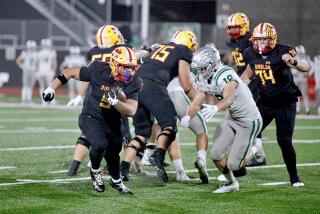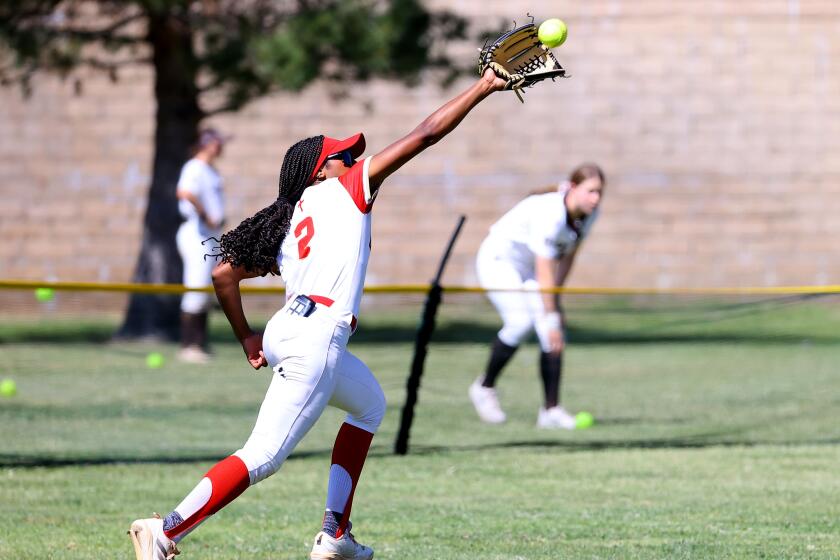IT FITS THEM TO A ‘T’ : At Age 39, Offensive Formation Still Provides Punch for Some Football Teams
- Share via
SAN DIEGO — The 1950 football season was about to get under way, and David Nelson was worried. The last thing he wanted was a repeat of 1949.
Nelson, then the head coach at Maine, had just suffered through his first losing season. He discovered that a roster of 15 or 16 players had left him short on talent and depth. Injury had taken its toll on his lone quality back, and he didn’t have a center who could snap the ball far enough to reach the quarterback.
Nelson knew something would have to change, or 1950 could look the same as ’49.
“The night before the first team meeting of 1950, I just decided we were going to have to make a change,” said Nelson, 69. “Like a lot of things, it came out of necessity.”
Nelson’s decision was to install a wing-T offense.
It didn’t seem all that big of a deal, except maybe to the staff and players of the small college. But the move would have big ramifications a year later.
Nelson moved on to the University of Delaware in 1951, taking along his idea of combining the wing T with elements of the option.
The Delaware wing T, a child of necessity, was born.
“The first year, we didn’t use it all the time, but we only lost one game,” said Nelson, now dean of physical education at Delaware. “We just combined the wing T with option football. At that time, it fit like a nut and a bolt against the defenses that were being used.”
And it still fits today. The Delaware wing T has been used by major colleges through the years. “Iowa used it in 1956 when they won the Big Ten, it got on TV, and people saw it,” Nelson said. “In 1958, LSU won the national title with it, and so did Ara Parseghian at Notre Dame in 1973.” But today, it is more popular among high schools and small colleges in the East and gaining popularity in the West. Several San Diego County high schools, plus the University of San Diego, are using all or part of the plan.
“It’s more than a formation,” said Tubby Raymond, head coach at Delaware. “It’s a philosophy of football.”
The philosophy is based on the premise that appearances can be deceiving. Delaware wing-T disciples preach that no matter how small, how weak or how slow a team appears, it can compete against more-talented competition. And win.
The Delaware wing T utilizes four backs--quarterback, tailback, fullback and wingback. Any of the four can carry the ball, or the quarterback can use play action and pass. A typical play will have two backs faking, one back blocking and the fourth carrying the ball.
But the key is the misdirection and trapping used by the line. Under this system, a lineman is seldom used for one-on-one blocking, which means a team doesn’t have to worry as much about being physically overmatched.
Adding to the confusion is the Delaware wing T’s use of similar looks. The offense is run in a series. Each series consists of different plays run out of the same formation. Although the plays are different, they look strikingly similar to the defense. Combine this with four backs and play action, and the defense is never quite sure where the ball is going.
“It’s been slowly getting more popular (in the West),” said Jack Fogarty, who plays host to a Delaware wing T clinic each spring at Canyon Springs High School in Moreno Valley. Fogarty said that the clinic drew 126 high school coaches from California, Washington, Oregon and Arizona two years ago. Last year’s clinic drew 50 coaches, but that was because there are now several clinics being offered on the west coast.
“It’s kind of an equalizer,” said Fogarty, whose team won the Southern Section 2-A title last season and is ranked No. 1 this year. “You can just get away with a lot more. We are able to compete with teams we probably should not have been on the same field with.”
Ed Burke, coach at San Dieguito, has used the offense the past five years. Several top county teams have used part of the Delaware wing T, including Morse, Rancho Buena Vista, and, at one time, Point Loma and Vista.
But true devotees believe in all or nothing. “(Part-time users are) not what I consider purists,” Burke said with a chuckle.
Burke, like many others, was a skeptic at first.
“I was a wishbone coach for 10 years,” he said. “But I went through a couple years with quarterback injuries that hurt us. I was searching for something else to do because of that. Doug Scovil was running the BYU offense at San Diego State, and I spent some time at SDSU for a week of spring practice and then went to BYU to study that offense. I decided to install the offense but I wasn’t really happy with it.
“In the wishbone and BYU offenses, if one player has a bad game, you have a bad game. I found out quickly I had the same problem (as with the wishbone). If the quarterback had a bad night, and he’s throwing 35 times, we usually lost.”
Burke went to a clinic put on by Herb Meyer, coach at El Camino. There he heard Mike Churchill, the coach at Riverside Poly and a Delaware wing T advocate.
“In listening to his talk, it was so similar in concept to the wishbone, that it drew me to it.”
Burke, then at Torrey Pines, decided to wait a year and instead went with the BYU offense. He then moved to San Dieguito. With a new coaching staff, it seemed an opportune time to change.
“With the wing T, it doesn’t rely on one person so much,” Burke said. “The other thing that appeals to me is you don’t have to have big linemen because of the double blocking. You’re not depending on an outstanding player. All the backs have to block for each other. I thought that would strengthen team unity.”
The first year using the Delaware wing T, San Dieguito was 2-6-1. Since then, the Mustangs have gone to the playoffs in the tough Palomar League three consecutive seasons. This year, San Dieguito is 3-0 and ranked No. 6 in the county.
When Doug Coffin moved from assistant to head coach at Santana in 1987, he knew something was going to have to change. The program was a mess. The Sultans had experienced mutiny by players, had not had a winning season since 1973 and had made the playoffs only twice in the last 23 years.
Coffin’s solution was the Delaware wing T.
“Year in and year out, it fits the type of personality and athletic ability we have,” Coffin said. “I think it’s a great high school offense. But it’s harder than heck to coach.”
In the spring, many coaches return to the University of Delaware to fine-tune their knowledge of the offense during spring practice. Coffin and Burke have both made these springtime trips.
“If I had not gone back to Delaware, I don’t know how well we would have done with it,” Coffin said. “There are so many little things. We use parts of three series. But there are 400 different series.
“You have to have real discipline. That’s really helped our team. We were well-known for being undisciplined. You have to get rid of the attitude of being an individual. It’s a real team offense.”
In Coffin’s first year, Santana went 2-6-2 while he laid the groundwork. Last year, Santana was 6-4, won its first league title and went to the playoffs for the first time since 1977. This year the Sultans are 2-0-1, the best start in the school’s history.
Mira Mesa Coach Brad Griffith is using the offense for the first time this year. The Marauders are struggling, having scored seven points in their past two games. But Mira Mesa is 2-1 and could challenge Morse and Point Loma for the Eastern League title.
“We still need to work some bugs out,” Griffith said. “Actually, Chula Vista shut us out (14-0), but we probably had close to 400 yards in offense. We have yet, as coaches, to master it. Our offensive coordinator still thinks in old terms. It’s like the guy who speaks English but has learned Spanish. Someone talks to him in Spanish, and he as to think about it in English and then say it in Spanish.”
Griffith came upon the Delaware wing T when he was looking for a way to utilize three good running backs at the same time.
“We talked to some other coaches about it, and our defensive coach said it’s a bear defending it,” Griffith said. “The plays look alike, so a defender has to wait to see what develops. You have to have control. If you don’t you can be in trouble.
“With all the misdirection we’ve been able to run the ball better. In fact, I wish we had gone to it a couple of years ago.”
Brian Fogarty, coach at the University of San Diego, is another in a long list of coaches who switched to the Delaware wing T out of necessity.
Fogarty used to live and die by the I. But when you’re the coach at a Division III college, your tailbacks have a tendency to be 150 pounds, not 190. Fogarty was finding that his backs were taking a pounding, and the subsequent injuries were hurting the team.
So Fogarty decided to take a look at the Delaware wing T last year. He didn’t have to look far. All he had to do was call his brother Jack, the coach at Canyon Springs.
“When he told me he was thinking of going to the Delaware wing T, I almost fell over and died,” Jack said. “He’s was a Nebraska I man. I never thought he’d switch.
“He used to joke with me about our secret society. Well, he’s been doing it for a couple years. Maybe it’s time I show him our secret handshake.”
More to Read
Get our high school sports newsletter
Prep Rally is devoted to the SoCal high school sports experience, bringing you scores, stories and a behind-the-scenes look at what makes prep sports so popular.
You may occasionally receive promotional content from the Los Angeles Times.






